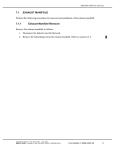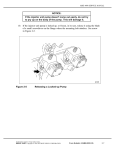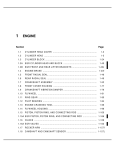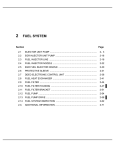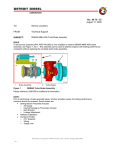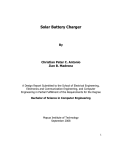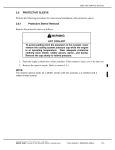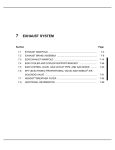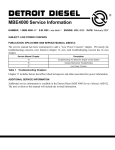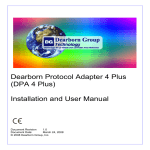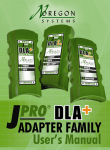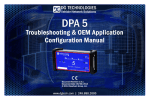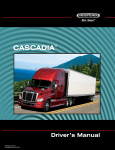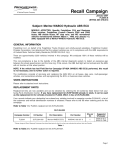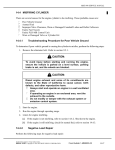Download 2.9 FUEL SYSTEM INSPECTION
Transcript
MBE 4000 SERVICE MANUAL 2.9 FUEL SYSTEM INSPECTION Perform the following steps to inspect the fuel system for damage: To avoid injury from penetrating fluids, do not put your hands in front of fluid under pressure. Fluids under pressure can penetrate skin and clothing. To avoid injury from fire, keep all potential ignition sources away from diesel fuel, open flames, sparks, and electrical resistance heating elements. Do not smoke when refueling. NOTE: For additional safety precautions, refer to the General Information section of the MBE 4000 Service Manual (6SE412). 1. Check fuel delivery lines looking for deformation or bent lines, creating restriction and/or obstruction of the flow. 2. Check suction lines and connections looking for damage or under torque, allowing air to enter the fuel system. 3. Check the fuel tank installation. Look for bent/blocked lines, and leaks. 4. Check high-pressure lines for leaks. Look for connector nut leaks at the unit pump and at the transfer tube on the cylinder head. In the event of leaks, disassemble and inspect the high-pressure lines/transfer tube. For proper torque specifications, see those listed in Table 2-2. Table 2-2 Component Torque Transfer Tube Nut 45 N·m (33 lb·ft) High Pressure Line Nuts 30 N·m (22 lb·ft) Torque Specifications for Fuel Line Nuts 5. Perform a fuel pressure test. Refer to section 2.9.1. All information subject to change without notice. 6SE412 0206 Copyright © 2003 DETROIT DIESEL CORPORATION From Bulletin 6-MBE4000-03 2-41 2.9 FUEL SYSTEM INSPECTION 2.9.1 Performing a Fuel Pressure Test Perform the following steps to conduct a fuel pressure test: 1. Install the pressure gauge on the fuel system. There are two possible setups for this installation. Setup 1 has the gauge installed after the fuel filter. See Figure 2-23. Setup 2 has the gauge installed before the fuel filter. See Figure 2-24. 1. Fitting 4. Fuel Outlet Line 2. Fuel Filter Housing 5. Unit Pump 3. Mechanical Gauge Figure 2-23 2-42 Gauge Installation – After the Fuel Filter From Bulletin 6-MBE4000-03 All information subject to change without notice. 6SE412 0206 Copyright © 2003 DETROIT DIESEL CORPORATION MBE 4000 SERVICE MANUAL 1. Fuel Pump 4. Fuel Outlet Line 2. Fitting 5. Mechanical Gauge 3. Fuel Filter Housing Figure 2-24 Gauge Installation – Before the Fuel Filter NOTE: The fitting applied in both setups is not a special tool and it is not included in the Mercedes-Benz kit or SPX kit. This fitting is a component and it can be ordered from Canton PDC under part number 915039012205. All information subject to change without notice. 6SE412 0206 Copyright © 2003 DETROIT DIESEL CORPORATION From Bulletin 6-MBE4000-03 2-43 2.9 FUEL SYSTEM INSPECTION To avoid injury before starting and running the engine, ensure the vehicle is parked on a level surface, parking brake is set, and the wheels are blocked. Diesel engine exhaust and some of its constituents are known to the State of California to cause cancer, birth defects, and other reproductive harm. Always start and operate an engine in a well ventilated area. If operating an engine in an enclosed area, vent the exhaust to the outside. Do not modify or tamper with the exhaust system or emission control system. 2. Start the engine and warm it up to working temperatures: 80 - 95 C (176 - 203 F). 3. Check the fuel pressure at two points: idle speed and rated speed. 4. Compare the test results with the fuel systems specifications for pressure listed in Table 2-3. If any of the readings are out of spec, follow the proper troubleshooting steps. Speed Pressure Fuel Pressure Test at idle rpm 2 bar (29 psi) –minimum Fuel Pressure Test at rated rpm 5.5 – 6.5 bar (80 – 95 psi) Maximum difference between fuel filter housing inlet and outlet pressure 0.3 bar (4 psi) Table 2-3 2.9.1.1 Fuel System Specifications for Pressure Fuel Pressure Test Troubleshooting Procedures For results out of specs on the fuel pressure test, check the following appropriate steps: 1. At idle rpm, with fuel pressure lower than 2 bar (29 psi), check the following: Check the pressure valve at the end of the fuel gallery. Look for opening pressure 2 bar (29 psi). Check the fuel pump assembly (bearing and/or driven gear). Check to see if the fuel system is drawing air. 2. At rated rpm, for fuel pressure lower than 5.5 bar (80 psi), check the following: Check the water separator filter condition. Check for restriction at the check valve on the PLD-MR heat exchange plate. 2-44 From Bulletin 6-MBE4000-03 All information subject to change without notice. 6SE412 0206 Copyright © 2003 DETROIT DIESEL CORPORATION MBE 4000 SERVICE MANUAL Check the main fuel filter condition, looking for saturation or any damaged seal allowing flow of fuel from the pressure side to the return side. Check for leaks at the suction lines from the tank. Check the fuel pump assembly (bearing and/or driven gear). Look for leaks and/or a damaged fuel pump. Check for restriction at the check valve on the fuel filter return line to tank. 3. At rated rpm, for fuel pressure higher than 6.5 bar (95 psi), check the following: Check the return line and injector spill line, looking for restrictions or bent lines. Check the fuel pressure valve for a blocked or restricted regulator orifice. 2.9.2 Performing a Fuel System Test using minidiag2 To perform a fuel system test using minidiag2, perform the following steps: To avoid injury when working near or on an operating engine, remove loose items of clothing, jewelry, tie back or contain long hair that could be caught in any moving part causing injury. Diesel engine exhaust and some of its constituents are known to the State of California to cause cancer, birth defects, and other reproductive harm. Always start and operate an engine in a well ventilated area. If operating an engine in an enclosed area, vent the exhaust to the outside. Do not modify or tamper with the exhaust system or emission control system. NOTE: Before running the test, warm the engine to normal operating temperatures: 80 -95 C (176 -203 F). 1. Plug your minidiag2 into the truck diagnostic connector and follow the instructions in the minidiag2 Supplement Manual to connect to the VCU/PLD-MR system. 2. After establishing the connection with the truck, choose option 4 – Routines. 3. Under Routines section, select option 4 – Idle Smoothly Balance. All information subject to change without notice. 6SE412 0206 Copyright © 2003 DETROIT DIESEL CORPORATION From Bulletin 6-MBE4000-03 2-45 2.9 FUEL SYSTEM INSPECTION 4. Check each cylinder value for this routine and compare your results with the troubleshooting and proceed as described for any results out of spec. Refer to section 2.9.2.1. 5. Still connected to truck, look for option 5 – Impact Time Delay, under the Routines section. 6. Select it and check each cylinder value for this routine and compare your results with the troubleshooting and proceed as described for results out of spec. 2.9.2.1 Idle Smoothly Balance Troubleshooting This test measures the percentage of fuel delivery for each cylinder in order to maintain a smooth operation at idle. Operational range for this test: from -3% (negative) to 3% (positive). Identify the cylinder with the biggest absolute value – highest positive or lowest negative. The troubleshooting steps for both conditions are: For Highest Positive: 1. Check torque at all the transfer tubes nuts (45 N·m [33 lb·ft]). Run the test again. If the results are out of operational range, proceed to next step. 2. Find the cylinder with the result closest to zero. Swap the injector nozzle holder and the transfer tube between this cylinder and the cylinder with the highest result. Run the test again. If the highest result follows the injector nozzle holder, replace the nozzle holder. If not, proceed to the next step. NOTE: After removing the injector nozzle holders and transfer tubes, check the coupling area between both components and the seal rings. If any defect or damage is found, replace the damaged parts. 3. Return both injector nozzle holders and transfer tubes to their original positions and run the impact delay time and compression test routines. For Lowest Negative: 1. Check torque at all the transfer tubes nuts (45 N·m [33 lb·ft]). Run the test again. If the results are out of the operational range, proceed to the next step. 2. Find the cylinder with the lowest result, remove the injector nozzle holder and check the opening pressure. If the pressure is lower than the minimum spec (275 bar [3989 psi]), replace the injector nozzle holder. If the pressure is within the spec, proceed to the next step. 3. Run a compression test using minidiag2, ProLink reader, or DDDL 5.0 (refer to the Diagnostic Tool Manual for instructions to run this test). The readings must be 75% or higher. For readings lower than 75%, remove the oil pan and cylinder head and check for damaged components. 2-46 From Bulletin 6-MBE4000-03 All information subject to change without notice. 6SE412 0206 Copyright © 2003 DETROIT DIESEL CORPORATION MBE 4000 SERVICE MANUAL 2.9.2.2 Impact Delay Time Troubleshooting This test measures the reaction time of the unit pumps. The operation range is from 1.2 to 2.1 milliseconds. Perform the following troubleshooting procedure for values out of the operating range: 1. Check the engine harness from the PLD-MR to the suspected unit pump – connectors and wire. Look for bad or loose connections and broken wires. If there are none, proceed to the next step. 2. Swap the suspect unit pump with one operating properly and run the test again. Refer to section 2.1.1 for unit pump removal and refer to section 2.1.2 for unit pump installation. If the condition follows the unit pump, replace the unit pump. 2.9.2.3 Checking the Fuel Pump Driven Gear Bolt Torque This procedure describes how to check the fuel pump assembly for any play or wear on the fuel pump shaft drive gear mounting bolt. Any play in this component has a big impact on engine performance. 1. Remove the fuel pump. 2. Set the torque wrench to 30 N·m (22 lb·ft). All information subject to change without notice. 6SE412 0206 Copyright © 2003 DETROIT DIESEL CORPORATION From Bulletin 6-MBE4000-03 2-47 2.9 FUEL SYSTEM INSPECTION NOTICE: Do not apply a torque over 30 N·m (22 lb·ft). Excessive torque can cause the bolt/gear failure. 3. Turn the torque wrench as shown by the arrow in until the torque wrench “clicks.” This resistance ensures that the fuel pump drive gear is in good condition. In the event of NO resistance found with shaft turning freely, proceed to the next step. See Figure 2-25. 1. Torque wrench 3. Fuel Pump 2. Fuel Pump Drive Gear Splines Figure 2-25 Checking Fuel Pump Drive Gear 4. Remove the fuel pump drive gear cover. 2-48 From Bulletin 6-MBE4000-03 All information subject to change without notice. 6SE412 0206 Copyright © 2003 DETROIT DIESEL CORPORATION MBE 4000 SERVICE MANUAL 5. Remove the bolt and gear. See Figure 2-26. 1. Cover 3. Fuel Pump Shaft 2. Drive Gear Mounting Bolt 4. Fuel Pump Drive Gear Figure 2-26 Removing/Installing Fuel Pump Drive Gear and Bolt 6. Check the mounting between bolt, gear, and shaft. Look for damaged parts. Replace any damaged part in order to avoid it coming loose again. 7. Install gear and bolt. Apply Loctite® 271 sealant to the bolt. For the correct tightening of the bolt, install the special tool J 36187 to the fuel pump spline and block the shaft movement. See Figure 2-25. 8. Torque bolt to 30 N·m (22 lb·ft). 9. Apply Loctite 574 sealant and install the cover. Torque 50 N·m (37 lb·ft). 10. Install new gasket and the fuel pump. Torque to the fuel pump bolts will be 25 N·m (18 lb·ft). All information subject to change without notice. 6SE412 0206 Copyright © 2003 DETROIT DIESEL CORPORATION From Bulletin 6-MBE4000-03 2-49 2.9 2-50 FUEL SYSTEM INSPECTION From Bulletin 6-MBE4000-03 All information subject to change without notice. 6SE412 0206 Copyright © 2003 DETROIT DIESEL CORPORATION MBE 4000 SERVICE MANUAL 2.A ADDITIONAL INFORMATION Description Page SPECIFICATIONS ............................................................................................. 2-52 Fuel Injectors .................................................................................................. 2-52 Engine Brake Harness ................................................................................... 2-53 Fuel and Fuel Control ..................................................................................... 2-54 Fuel System Inspection .................................................................................. 2-59 All information subject to change without notice. 6SE412 0206 Copyright © 2003 DETROIT DIESEL CORPORATION From Bulletin 6-MBE4000-03 2-51 SPECIFICATIONS This section contains the specifications for servicing the engine. Fuel Injectors The fuel injection system torque values are listed in Table 2-4. The torque values for the injector lines are listed in Table 2-5. Fastener Type N·m (lb·ft) Fuel Filter Cap Nut 25 (18) Fuel Return Line Fittings (at fuel gallery inlet) 50 (37) Hollow-Core Banjo Bolts 50 (37) Pressure Limiting Valve (at fuel gallery outlet) 50 (37) Protective Sleeve 45 (33) Tensioning Arm Retaining Bolt 50 (37) Unit Pump Mounting Bolts 65 (48) Table 2-4 Fuel Injection System Torque Values Fastener Type N·m (lb·ft) Using a 12-in. torque wrench Using a 24-in. torque wrench Required Torque on Fastener Injector Line Nuts 27 (20) 25 (18) 30 (22) Transfer Tube Thrust Bolt 40 (30) 36 (27) 45 (33) Table 2-5 2-52 Injector Lines Torque Values From Bulletin 6-MBE4000-03 All information subject to change without notice. 6SE412 0206 Copyright © 2003 DETROIT DIESEL CORPORATION MBE 4000 SERVICE MANUAL Engine Brake Harness The former 8-pin Engine Harness Connector is identified with part number A460 150 00 33, and it is used in the engines that have one solenoid air valve for the engine brakes. Beginning with the engine serial number 739080, these current engines will have an 8-pin Engine Harness Connector with part number A460 150 01 33. The changes in the harness connections between the former and current 8-pin harness connector are Listed in Table 2-6and listed in Table 2-7. Description 8-Pin Engine Harness Connector PLD-MR 55-Pin Connector Fan Control 1, switch to Bat- (PV3) A 41 Fan Control 2, switch to Bat- (PV4) B 43 Output Ground (PV) C 11 Fan and Wastegate/E-Flap Voltage Supply (PV1, 3, 4) D 12 Exhaust Flap/Wastegate Control, switch to Bat- (PV1) E 51 Fan and Wastegate/E-Flap Voltage Supply (PV1, 3, 4) F 12 Turbo Brake Control, switch to Bat(PV6) G 40 Turbo Brake Voltage Supply (PV6) H 42 Table 2-6 Former Harness Connector A460 150 00 33 Description 8-Pin Engine Harness Connector PLD-MR 55-Pin Connector Fan Control #1, switch to Bat- (PV3) A 41 Fan Control #2, switch to Bat- (PV4) B 43 Compression Brake Control, switch to Bat- (PV2) C 50 Fan and Wastegate/E-Flap Voltage Supply (PV1, 3, 4) D 12 Exhaust Flap/Wastegate Control, switch to Bat- (PV1) E 51 Compression Brake Voltage Supply (PV2) F 52 Turbo Brake Control, switch to Bat(PV6) G 40 Turbo Brake Voltage Supply (PV6) H 42 Table 2-7 Current Harness Connector A460 150 01 33 All information subject to change without notice. 6SE412 0206 Copyright © 2003 DETROIT DIESEL CORPORATION From Bulletin 6-MBE4000-03 2-53 Fuel and Fuel Control The fuel control torque values are listed in Table 2-8. Listed in Table 2-9 and listed in Table 2-10 are the fuel system torque values. See Figure 2-27 for a harness drawing of the wiring from the PLD (pump and nozzle) control unit. For a detailed (partial) harness drawing showing the interface between the PLD and the vehicle control unit (VCU) through the electronic engine frontwall connector, see Figure 2-28. For a detailed (partial) harness drawing showing the PLD wiring to the proportioning valves and the oil system sensors, see Figure 2-29. For a detailed (partial) harness drawing showing the PLD wiring to the other system sensors, including charge air, coolant, fuel, crank angle position, and TDC (top dead center), see Figure 2-30. Fastener Type N·m (lb·ft) Fuel Heat Exchanger Mounting Bolts 8 (6) Fuel Lines 50 (37) PLD Control Unit Mounting Bolts 15 (11) Table 2-8 Fuel Control Torque Values Fastener Torque Value, mm (in.) Fuel Filter Cap 25 (18) Fuel Line Banjo Bolts 50 (37) Fuel Line Pipe Fittings 50 (37) High-Pressure Fuel Lines 30 (22) Fuel/Water Separator Mounting Nuts 50 (37) Fuel Filter Housing Mounting Bolts 25 (18) Fuel Pump Mounting Bolts 25 (18) Table 2-9 Fuel System Torque Values Fastener Torque, mm (in.) Fuel Spill Line Banjo Bolt 15 (11) Fuel Pump Driven Gear Bolt 30 (22) Fuel Temperature Sensor to Engine Block 30 (22) Table 2-10 2-54 Fuel System Torque Values From Bulletin 6-MBE4000-03 All information subject to change without notice. 6SE412 0206 Copyright © 2003 DETROIT DIESEL CORPORATION MBE 4000 SERVICE MANUAL Figure 2-27 PLD Control Unit Wiring All information subject to change without notice. 6SE412 0206 Copyright © 2003 DETROIT DIESEL CORPORATION From Bulletin 6-MBE4000-03 2-55 Figure 2-28 2-56 PLD Control Unit Wiring, VCU Interface From Bulletin 6-MBE4000-03 All information subject to change without notice. 6SE412 0206 Copyright © 2003 DETROIT DIESEL CORPORATION MBE 4000 SERVICE MANUAL Figure 2-29 PLD Control Unit Wiring, Proportioning Valves and Oil System Sensors All information subject to change without notice. 6SE412 0206 Copyright © 2003 DETROIT DIESEL CORPORATION From Bulletin 6-MBE4000-03 2-57 Figure 2-30 2-58 PLD Control Unit Wiring, Miscellaneous Sensors From Bulletin 6-MBE4000-03 All information subject to change without notice. 6SE412 0206 Copyright © 2003 DETROIT DIESEL CORPORATION MBE 4000 SERVICE MANUAL Fuel System Inspection The torque specifications for fuel line nuts are listed in Table 2-11. The fuel system specifications for pressure are listed in Table 2-12. Table 2-11 Component Torque Transfer Tube Nut 45 N·m (33 lb·ft) High Pressure Line Nuts 30 N·m (22 lb·ft) Torque Specifications for Fuel Line Nuts Speed Pressure Fuel Pressure Test at idle rpm 2 bar (29 psi) – minimum Fuel Pressure Test at rated rpm 5.5 – 6.5 bar (80 – 95 psi) Maximum difference between fuel filter housing inlet and outlet pressure 0.3 bar (4 psi) Table 2-12 Fuel System Specifications for Pressure All information subject to change without notice. 6SE412 0206 Copyright © 2003 DETROIT DIESEL CORPORATION From Bulletin 6-MBE4000-03 2-59 2-60 From Bulletin 6-MBE4000-03 All information subject to change without notice. 6SE412 0206 Copyright © 2003 DETROIT DIESEL CORPORATION




















